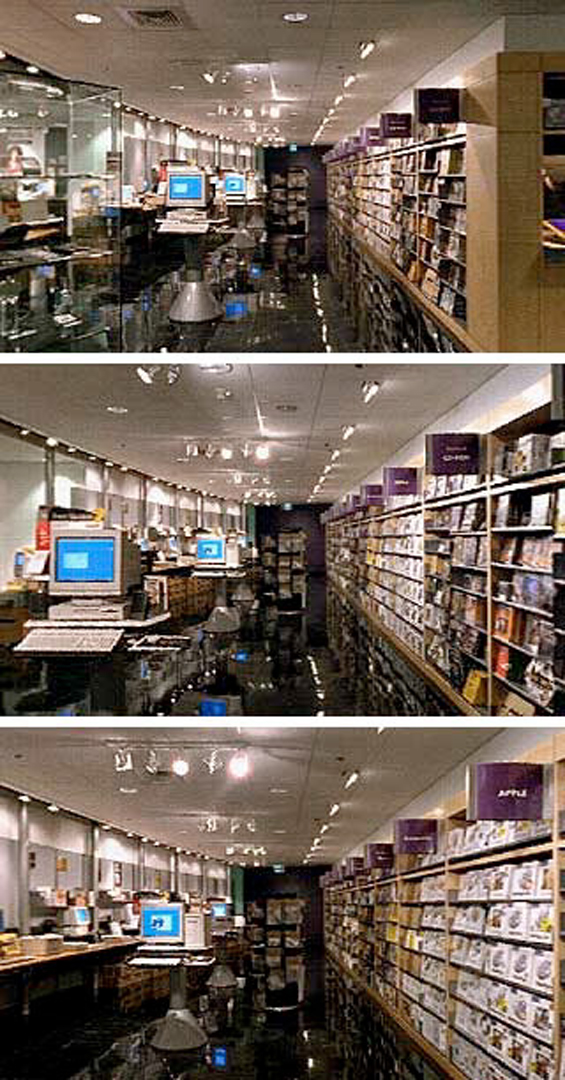“QuickTime VR: an image-based approach to virtual environment navigation” by Chen
Conference:
Type(s):
Title:
- QuickTime VR: an image-based approach to virtual environment navigation
Presenter(s)/Author(s):
Abstract:
Traditionally, virtual reality systems use 3D computer graphics to model and render virtual environments in real-time. This approach usually requires laborious modeling and expensive special purpose rendering hardware. The rendering quality and scene complexity are often limited because of the real-time constraint. This paper presents a new approach which uses 360-degree cylindrical panoramic images to compose a virtual environment. The panoramic image is digitally warped on-the-fly to simulate camera panning and zooming. The panoramic images can be created with computer rendering, specialized panoramic cameras or by “stitching” together overlapping photographs taken with a regular camera. Walking in a space is currently accomplished by “hopping” to different panoramic points. The image-based approach has been used in the commercial product QuickTime VR, a virtual reality extension to Apple Computer’s QuickTime digital multimedia framework. The paper describes the architecture, the file format, the authoring process and the interactive players of the VR system. In addition to panoramic viewing, the system includes viewing of an object from different directions and hit-testing through orientation-independent hot spots.
References:
1. Lippman, A. Movie Maps: An Application ofthe Optical Videodisc to Computer Graphics. Computer Graphics(Proc. SIGGRAPH’80), 32-43.
2. Ripley, D. G. DVI-a Digital Multimedia Technology. Communications ofthe ACM. 32(7):811-822. 1989.
3. Miller, G., E Hoffert, S. E Chen, E Patterson, D. Blackketter, S. Rubin, S. A. Applin, D. Yim, J. Hanan. qqae Virtual Museum: Interactive 3 D Navigation of a Multimedia Database. qqae Journal ofVisualization andComputer Animation, (3): 183-197, 1992.
4. Mohl, R. CognitiveSp ace in the Interactive Movie Map: an Investigation of Spatial Learning in the Virtual Environments. MIT Doctoral Thesis, 1981.
5. Apple Computer, Inc. QuickTime, Version 1.5 for Developers CD. 1992.
6. Blinn, J. F. andM. E. Newell. Texture and Reflection in Computer Generated Images. Communications of the ACM, 19(10):542-547. October 1976.
7. Hall, R. Hybrid Techniques for RapidImage Synthesis. in Whitted, T. and R. Cook, eds. Image Rendering Tricks, Course Notes 16 for SIGGRAPH’86. August 1986.
8. Greene, N. Environment Mapping andOther Applications of World Projections. Computer Graphics and Applications, 6(11):21-29. November 1986.
9. Yelick, S. Anamorphic Image Processing. B.S. Thesis. Department of Electrical Engineering and Computer Science. May, 1980.
10. Hodges, M and R. Sasnett. Multimedia Computing- Case Studies from MIT Project Athena. 89-102. Addison-Wesley. 1993.
11. Miller, G. andS. E. Chen. Real-Time Display of Surroundings using Environment Maps. Technical Report No. 44, 1993, Apple Computer, Inc.
12. Greene, N andM. Kass. Approximating Visibility with Environment Maps. Technical Report No. 41. Apple Computer, Inc.
13. Regan, M. and R. Pose. Priority Rendering with a Virtual Reality Address Recalculation Pipeline. Computer Graphics (Proc. SIGGRAPH’94), 155-162.
14. Greene, N. Creating Raster Ominmax Images from Multiple Perspective Views using the Elliptical Weighted Average Filter. IEEE Computer Graphics and Applications. 6(6):21-27, June, 1986.
15. Irani, M. and S. Peleg. Improving Resolution by Image Registration. Graphical Models and Image Processing. (3), May, 1991.
16. Szeliski, R. Image Mosaicing for Tele-Reality Applications. DEC Cambridge Research Lab Technical Report, CRL 94/2. May, 1994.
17. Mann, S. and R. W. Picard. Virtual Bellows: Constructing High Quality Stills from Video. Proceedings of ICIP-94. 363- 367. November, 1994.
18. Chen, S. E. and L. Williams. View Interpolation for Image Synthesis. Computer Graphics(Proc. SIGGRAPH’93), 279-288.
19. Cheng, N. L. View Reconstruction form Uncalibrated Cameras for Three-Dimensional Scenes. Master’s Thesis, Department of Electrical Engineering and Computer Sciences, U. C. Berkeley. 1995.
20. Laveau, S. and O. Faugeras. 3-D Scene Representation as a Collection of Images and Fundamental Matrices. INRIA, Technical Report No. 2205, February, 1994.
21. Williams, L. Pyramidal Parametrics. Computer Graphics(Proc. SIGGRAPH’83), 1-11.
22. Berman, D. R., J. T. Bartell and D. H. Salesin. Multiresolution Painting and Compositing. Computer Graphics (Proc. SIGGRAPH’94), 85-90.
23. Perlin, K. andD. Fox. Pad: An Alternative Approach to the Computer Interface. Computer Graphics (Proc. SIGGRAPH’93), 57-72.
24. Hoffert, E., L. Mighdoll, M. Kreuger, M. Mills, J. Cohen, et al. QuickTime: an Extensible Standard for Digital Multimedia. Proceedings of the IEEE Computer Conference (CompCon’92), February 1992.
25. Apple Computer, Inc. Inside Macintosh: QuickTime. Addison-Wesley. 1993.
26. Chen, S. E. and G. S. P. Miller. Cylindrical to planar image mapping using scanline coherence. United States Patent number 5,396,583. Mar. 7, 1995.
27. Chen, M. A Study in Interactive 3-D Rotation Using 2-D Control Devices. Computer Graphics (Proc. SIGGRAPH’88), 121-130.
28. Weghorst, H., G. Hooper andD. Greenberg. Improved Computational Methods for Ray Tracing. ACM Transactions on Graphics. 3(1):52-69. 1986.
29. ‘Electronic Panning’ Device Opens Viewing Range. Digital Media: A Seybold Report. 2(3): 13-14. August, 1992.
30. Clark, J. H. Hierarchical Geometric Models for Visible Surface Algorithms. Communications of the ACM, (19)10:547- 554. October, 1976
31. Funkhouser, T. A. and C. H. Sdquin. Adaptive Display Algorithm for Interactive Frame Rates During Visualization of Complex Virtual Environments. Computer Graphics(Proc. SIGGRAPH’93), 247-254.





